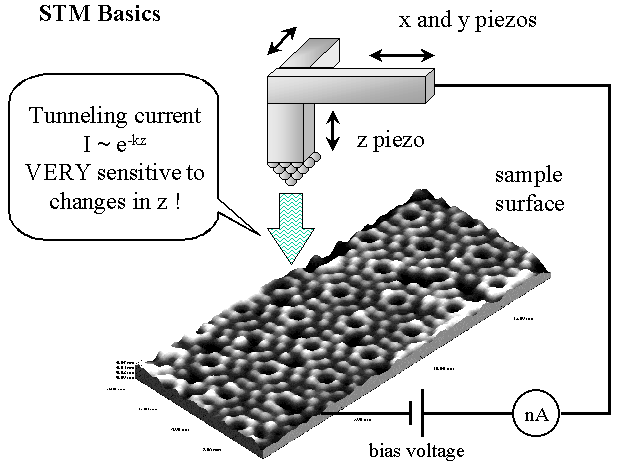Spin-Polarized Scanning Tunneling Microscopy
Literature Review by Dmitri Y. Petrovykh
- Introduction
- SPSTM Basics
- Spin-Polarized Tunneling
- SPSTM with Magnetic Tips
- Optically Pumped Tips
- SPSTM Q&A
- References
II. Spin-Polarized STM Basics
The general principle behind SPSTM is the same as for regular STM. A piezo-electric crystal is used to accurately position an atomically sharp tip above a sample (Fig. 1). Changing the position in the lateral (x,y) plane allows to scan continuously across the sample surface and changing the vertical (z) position allows to maintain desired tip-sample distance. If that distance becomes small enough (10–0.1 Angstroms) and voltage is applied between the sample and the tip, the tunneling current (1–0.1 nA) can be observed. This current depends exponentially on the tip-sample separation. Therefore if a feedback loop is used to adjust the vertical position to keep the current constant (constant current scanning mode) tip-sample separation can be kept constant with great precision. Alternatively the z-coordinate can be held constant and the tunneling current recorded. Since the current is essentially proportional to the density of electronic states in the sample, the first method maps constant density of states contours and the second method maps the actual density of states.

Fig.1 Basic STM setup. Atomically sharp tip is mounted on 3 piezo crystals that allow precise positioning in 3 directions. Moving in (x,y) plane scans the tip across the sample, z piezo determines the tip-sample distance.
SPSTM uses the fact that if the tunneling electrons are spin-polarized, then the tunneling current strongly depends on the sample spin-state. The current increases when the two spin-polarizations are parallel and decreases when they are anti-parallel. Depending on the source of the spin-polarization of electrons we can have two types of SPSTM: magnetic (usually metallic) tip and optically pumped GaAs tip.
